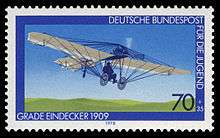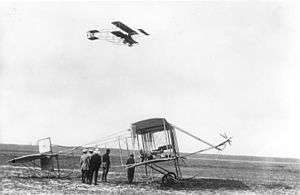Johannisthal Air Field
| Johannisthal Air Field | |
|---|---|
|
Flugplatz Berlin-Johannisthal, 1910 | |
| IATA: none – ICAO: none | |
| Summary | |
| Location | between Johannisthal and Adlershof |
| Opened | September 26, 1909 |
| Coordinates | 52°26′12.76″N 13°31′3.28″E / 52.4368778°N 13.5175778°ECoordinates: 52°26′12.76″N 13°31′3.28″E / 52.4368778°N 13.5175778°E |


The Johannisthal Air Field, located 15 km (9.3 mi) South-East of Berlin, between Johannisthal and Adlershof, was Germany's first airfield. It opened on 26 September 1909, a few weeks after the world's first airfield at Rheims, France.[1]
Overview
Known as the birthplace of heavier-than-air flight in Germany, Johannistal was Berlin's primary airport until the Tempelhofer Field was developed in the 1920s.
Johannistal was the field from which Germany's first commercial flights took off; and numerous aviation pioneers operated workshops there, including Anthony Fokker.
Later the area became known as Adlershof, and before the collapse of the Berlin Wall, it was closed to the public. The former airport was used by the National People's Army as a military training ground; while the Academy of Sciences of the GDR (with 14 natural science-technical institutions and six service centres) employed approximately 5,500 scientists and technicians.
Following the reunification of Germany, some of these research institutions were taken over by West German institutions, along with about 1,400 of the employees.
The Johannisthal field is today a major urban development, the Berlin-Adlershof City of Science and Technology. By 2003 a new district will be built on the 4.20 square kilometre property. The area will accommodate high-tech industries, science and research institutes and a congress centre, as well as a sport and recreation centre. The former home of the East German TV (DFF) will be transformed into a media centre. In total, there will be 30,000 jobs and housing for 15,000 people.
Laboratories, motor test beds, wind tunnels and hangars, erected in the 1920s and 1930s by the German Experimental Institute for Aviation (Deutsche Versuchsanstalt für Luftfahrt – DVL, the ancestor of today's DLR), are historical landmarks of the Aerodynamic Park today. The runways are part of a new green biotop.
Accidents
The 1913 Johannisthal Air Disaster happened close to the air field, killing all 28 passengers. The German astronaut Reinhard Furrer died on September 9, 1995 during historic flight show.
References
External links
![]() Media related to Flugplatz Berlin-Johannisthal at Wikimedia Commons
Media related to Flugplatz Berlin-Johannisthal at Wikimedia Commons
